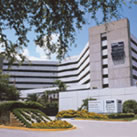
|
by Susan Jenks, Florida Today (reprinted by permission) May 2, 2008 -- Melbourne, Florida -- Palm Bay residents Frank and Florence Fondrisi have metal scaffolding, called stents, inside their arteries to keep blood flowing smoothly to the heart. But the couple, both in their early 70s, got their stents in a somewhat unusual way -- through an artery in the wrist, rather than through the groin, a far more common arterial pathway. He calls us "Mr. and Mrs. Radial Stent," said Frank Fondrisi, laughing, referring to the radial artery in the wrist through which Dr. Norberto Schechtmann slid a balloon-tipped catheter to reach the heart and restore blood flow. The stent keeps the artery open. "It's a lot less intrusive," said Fondrisi, citing his experience in the past with the groin route. "I've had enough of the other."
Schechtmann said he became interested in the procedure several years ago while visiting China, where 90 percent of heart doctors use the radial artery to access the heart. Ever since, he said, "I do it this way because I see how patients look and feel afterward. " Not only can patients sit in a chair soon after the procedure, he said, but they feel better quickly, requiring less nursing care and less space inside the hospital for recovery. Recently, Schechtmann guided a catheter through a sheath in the wrist of a heart patient at Holmes, who did not want to be identified. She had a single blockage in the right coronary artery, which Schechtmann described "as not that significant," but still causing her pain.His main concern, he said, was that the radial artery might shut down because it is so much smaller than the femoral leg artery and prone to spasms. " This doesn't happen often," he said, but "the first hit is the best hit" to get inside the arterial system efficiently. "And, you have to take your time." Other cardiologists agreed. "There is a steep learning curve" with the radial approach, said Dr. Srinivas Prasad, a heart doctor with Brevard Cardiology Group who has offered this option to some of his heart patients during the past few years. "It takes a more skilled technique," not only because of the spasm risk, he said, but also because it requires the use of smaller needles and a catheter shape often "more conducive to the groin" than the radial artery. But, like Schechtmann, he said, the rewards for patients can be immediate, as many are able to sit up right after the procedure, rather than lie flat on their back to prevent internal bleeding, a complication in 2 percent to 4 percent of groin porcedures. In an obese patient, that bleeding risk can be "catastrophic," said Prasad, on staff at Wuesthoff-Rockledge. Comfort is key And, while bleeding is more easily controlled if you go through the wrist, he said, multiple studies show complications, such as infection rates, tend to be comparable. However, patients definitely prefer the radial route, in terms of comfort, he said. Still, "it is a delicate procedure and you need to be respectful" of its limitations, especially if a patient has an inadequate blood supply to the hand, Rao stressed. What might be appropriate for a construction worker, for example, where "you don't necessarily need fine-hand motion," he said, might be inappropriate for a pianist facing a possible loss of function In the case of the Fondrisi couple, they simply followed their doctor's orders. "I think I was one of his (Schechtmann's) first patients," Frank Fondrisi recalled. "He said to me, 'Hold out your arm, I'm going through the wrist,' " and that was that. Six months later, in February, his wife went through the same scenario when a scan picked up a blockage in an artery on a Monday, followed by a stenting on a Wednesday. "She's doing fine," Fondrisi said. "You don't even know the stents are there. And I go out and play golf now several times a week." As for the unnamed patient in the Holmes operating room, the preparation time for the procedure took longer than the procedure itself, which Schechtmann completed in about 20 minutes. "It could not be better," he said, when he was done. "I want a thousand more cases to go just like this one. She lost very little blood, and I could not be happier. Everything went perfectly."After an overnight hospital stay, he said, the women would be released to her home, although she will have to stay on Plavix for a year to prevent potentially lethal clots from forming around her newly implanted stent. Contact Jenks at 321-242-3657 or e-mail sjenks@floridatoday.com.originally published on April 8, 2008 by Florida Today -- Reprinted by permission -- original article at http://www.floridatoday.com/apps/pbcs.dll/article?AID=/200804080108/LIFE01/804080320 |

